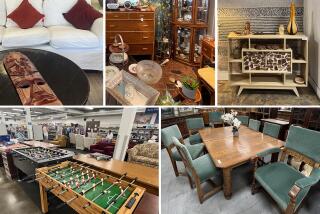Efficiency helps Vernon furniture factory keep its edge
- Share via
One in a series of occasional articles.
The streets around John Sandberg’s furniture factory are dotted with the shuttered shells of manufacturers that have closed down or left town.
But the Sandberg family, woodworkers for four generations, has found ways to keep Vernon-based Sandberg Furniture Co. going despite foreign competition, the nation’s stiffest environmental laws and the housing industry collapse.
For one of the state’s oldest furniture manufacturers, a maker of moderately priced bedroom furniture, survival is a matter of adaptability, Chief Executive John Sandberg said.
“We’ve had to be very efficient. We’ve become highly automated. We’ve had to cross-train our workers, in the factory and in the office,” Sandberg, 46, said. “But we are very good at what we do, and that’s why we are still here.”
Companies like Sandberg Furniture remain vital to the Southern California economy, experts say. The five-county region has more manufacturing jobs (669,300) than most states, surpassed only by the entire state and Texas.
“Manufacturers in Southern California have managed to hold on during trying times, but it certainly has not been easy,” said a recent report by the Los Angeles County Economic Development Corp., citing a 16.3% decline in local manufacturing jobs since 2006.
Few probably know that better than Sandberg, who has seen a 58.2% decline in furniture manufacturing employment from 2000 through the end of the decade in Southern California, a change to about 13,900 jobs from 33,200. That was the manufacturing sector’s second-worst workforce contraction, after the computer industry, which declined by 65.6%. Employment at Sandberg Furniture has fallen to about 150 employees from about 450 several years ago.
The main threat to the recovery of the U.S. furniture manufacturing industry is foreign competition, particularly from China, according to many U.S. furniture businesses.
In October, Sandberg and other furniture makers went to Washington to argue against eliminating so-called anti-dumping fees levied against importers of Chinese-manufactured goods sold in the U.S. for less than fair market value.
“Imports from China jumped 148% from 2001 to 2003,” said Joseph W. Dorn, a lawyer testifying on behalf of the furniture manufacturers. “The imports undersold domestic producers’ prices in each and every quarterly price comparison. The U.S. producers’ prices declined. So did their production and employment. The industry’s operating income fell by 57%. Sixty-five plants closed.”
U.S. importers have paid more than $500 million in retroactive anti-dumping duties since the system was implemented in 2005. Sandberg said that his share of the fees helped him stay in business.
“We made over $1.4 million in capital expenditures from fiscal 2004 to fiscal 2006, which is a considerable sum for a small company like us. Without the order, there is no question in my mind that Sandberg Furniture would already have been forced to close,” he said.
But Sandberg Furniture’s resilience has a long history.
The business was established in 1890 in Minnesota as Acme Furniture Manufacturing Co. by Sandberg’s great-grandfather Martin. In 1900, the family moved to California, and its main products were wooden crates and woven baskets to haul groceries and supplies at a time when there were no checkout lines or baggers.
The business boomed. “Then some guy invented the paper bag — oh, and the automobile too,” Sandberg quipped.
In 1918, the family decided to focus on bedroom furniture on the simple logic that there was usually more of it than anything else in a typical family home.
“One dining room. One living room, but there’s often more than one bedroom,” Sandberg said, explaining the family’s reasoning.
Martin Sandberg passed the business to his son, Arthur, who passed the business to his son, Albert. Next, John’s older brother Bill ran things until his death in 1999 at age 46. Now, a fifth generation is waiting in the wings, including John’s 28-year-old nephew, Scott, who is earning an MBA at USC.
Sandberg is well acquainted with the challenges of following so many skilled woodworkers in his family, as he learned in his very first shop class, where he thought things would come to him a lot more easily than they did.
“My first assignment was squaring and chamfering a block of wood. I failed it and had to do it over again,” Sandberg recalled with a grin. “My family used to say that sawdust runs in our blood, but at that point I wasn’t so sure.”
Before long, however, Sandberg was so good that he was chosen as a teacher’s assistant for the class.
It’s a determination that still serves Sandberg well; his company has faced an almost endless number of challenges since 1985. That was a period in which the Southern California furniture industry was a giant, $1.3-billion-a-year business employing more than 60,000 workers. But things were changing rapidly.
Between 1985 and 1990, 233 U.S. furniture companies, including 40 from California, moved their factories to Tijuana and other Mexican border cities. One was Douglas Furniture, a longtime Redondo Beach maker of dining-room furniture, which moved to reduce labor costs and avoid severe new California restrictions on solvent-based paints, stains and lacquers.
Said Douglas Vice President Harold Applebaum at the time: “If we wanted to stay in business, we had little or no alternative.”
The clean-air restrictions on manufacturing procedures are an ongoing factor because California is always at the forefront of new regulations. In 2007, for example, state regulators put forth tighter restrictions on formaldehyde gas seeping out of composite wood products such as plywood, particleboard and medium-density fiberboard, and more are on the way.
Eventually, other parts of the country catch up with the new environmental standards, but the additional cost burdens fall on California companies first.
The biggest challenge arrived in 2003, when the trickle of Chinese furniture imports became a deluge. Worse, no matter how Sandberg juggled the numbers on his analysis of the Chinese competitive landscape, the results were grim. The company was losing about 10% of its business annually.
“In investigating Chinese production of laminate bedroom furniture in 2003, I discovered that I could import completed and boxed product for less than our material cost. I knew we were in trouble,” Sandberg said.
It meant that Sandberg’s company had to become as efficient as possible and win its battle with better technologies and better quality.
“We make bedroom collections that use paper laminates instead of solid wood or wood veneers for the exposed surfaces,” Sandberg said. “Our company is a leader in the technology for making paper-laminate bedroom collections.”
Sandberg’s primary customers are low-income families and young adults just starting out. The company’s bedroom sets sell for $499 to $1,199, but the most popular sell for $899 to $999.
“That’s the sweet spot for us,” Sandberg said. Most of the company’s customers are in California, Texas, Florida and in the Chicago and New York areas.
Sandberg said the company keeps 7,000 bedroom sets in stock to respond quickly to inventory requests. He said it was another competitive advantage over the imports.
“We don’t have to wait weeks for it to arrive. We don’t have to wait for the boat to get here. We can supply our products quickly,” Sandberg said.
Two Schelling panel saws from Austria, one costing $800,000 and a smaller one $150,000, make software-programmed cuts of the laminated wood to leave as little waste as possible. The leftovers go to a Vernon meatpacking company “to help them turn their liquid waste products into solid waste,” Sandberg said.
Another machine, called a v-groover, cuts, bends and glues a single piece of laminate, eliminating the need for multiple machines, and more people, putting together four or five separate pieces, Sandberg said.
“It creates a piece that is far stronger and lighter than the way we used to do it, and it’s much faster because it uses a single piece,” Sandberg said. “This was a real strategic investment for us.”
The most important edge might come from a proprietary finishing technology called Ultragloss that creates a finish that is almost an optical illusion, making a lightweight piece of laminated wood look like a heavy block of marble.
“No one else we know of has anything like Ultragloss,” Sandberg said. “It’s also extremely durable, scratch resistant, dent resistant and chemical resistant. It’s one of our key strategic advantages.”
The privately held company doesn’t reveal sales statistics, but for the first time in years, he’s thinking sales will improve this year.
“We’re going to be able to keep this thing going,” he said.
More to Read
Inside the business of entertainment
The Wide Shot brings you news, analysis and insights on everything from streaming wars to production — and what it all means for the future.
You may occasionally receive promotional content from the Los Angeles Times.











